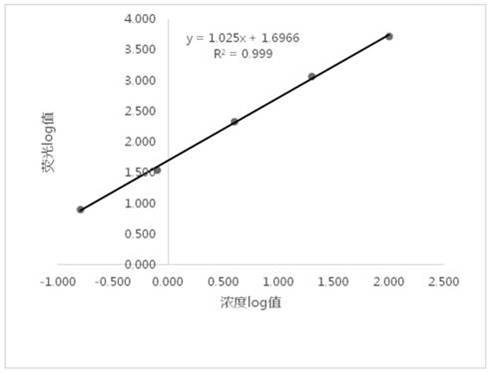Fluorescent magnetic bead micro-fluidic chip and analytical instrument thereof
A microfluidic chip and magnetic bead technology, which is applied in fluid controllers, instruments, and material analysis through optical means, can solve the problems of complex reaction process, many reagent components, and poor reaction effect, and achieve simple operation, The effect of less reagent consumption and less sample volume
- Summary
- Abstract
- Description
- Claims
- Application Information
AI Technical Summary
Problems solved by technology
Method used
Image
Examples
Embodiment 1
[0040] Below, with figure 1 The chip structure of the negative pressure one-step method is applied to the detection of C-reactive protein (CRP) as an example (double-antibody sandwich method detection), and the present invention is described:
[0041] (1) Antibody labeling
[0042] Add 1 mg of magnetic beads (polystyrene-coated iron compound, 3 μm in diameter, surface-modified carboxyl group), 10 μg of EDC and 15 μg of NHS solution and 20 μg of anti-CRP monoclonal antibody (CRP primary antibody) solution to 1 ml of 10 mM pH7.5 phosphate buffer solution, mix Uniform and react at room temperature for 4h, add 1mg lysine to block. Enrich with a magnet, remove unreacted antibodies, add 0.1% BSA 0.01M pH7.5 PBS solution 1ml to redissolve, and obtain CRP primary antibody-labeled capture magnetic beads solution.
[0043] Take 1ml of fluorescent microspheres with a solid content of 1% (europium compound coated with polystyrene, diameter 200nm, surface modified carboxyl group), add 15...
Embodiment 2
[0053] Below, with figure 2 The chip structure of the two-step negative pressure method is applied to the detection of serum amyloid A (SAA) as an example to illustrate the present invention:
[0054] (1) Antibody labeling
[0055] Add 1 mg of magnetic beads (polystyrene-coated iron compound, 3 μm in diameter, surface-modified carboxyl group), 10 μg of EDC and 15 μg of NHS solution and 15 μg of anti-SAA monoclonal antibody (SAA primary antibody) solution to 1 ml of 10 mM pH7.5 phosphate buffer solution, mix Uniform and react at room temperature for 4h, add 1mg lysine to block. Enrich with a magnet, remove unreacted components, add 0.1% BSA 0.01M pH7.5 PBS solution 1ml to redissolve, and obtain the SAA primary antibody-labeled capture magnetic bead solution.
[0056] Take 1ml of fluorescent microspheres with a solid content of 1% (europium compound coated with polystyrene, 200nm in diameter, carboxyl group modified on the surface), add 15mg of EDC and 50mg of sulfo-NHS solut...
Embodiment 3
[0065] Below, with image 3 The chip structure of the positive pressure one-step method is applied to the detection of 25 hydroxyvitamin D as an example (competitive method detection), and the present invention is described:
[0066] (1) Antibody labeling
[0067] Add 1 mg of magnetic beads (polystyrene-coated iron compound, 3 μm in diameter, surface-modified carboxyl group), 10 μg of EDC and 15 μg of NHS solution and 20 μg of BSA-coupled 25-hydroxyvitamin D (VD-BSA) into 1 ml of 10 mM pH7.5 phosphate buffer solution, mixed evenly and reacted at room temperature for 4h, adding 1mg of lysine to block. Enrich with a magnet, remove unreacted components, add 0.1% BSA 0.01M pH7.5 PBS solution 1ml to redissolve, and obtain VD-BSA labeled capture magnetic bead solution.
[0068] Take 1ml of fluorescent microspheres with a solid content of 1% (polystyrene coated europium compound, 200nm in diameter, surface modified carboxyl group), add 15mg EDC and 50mg sulfo-NHS solution and 30μg 25...
PUM
 Login to View More
Login to View More Abstract
Description
Claims
Application Information
 Login to View More
Login to View More - R&D Engineer
- R&D Manager
- IP Professional
- Industry Leading Data Capabilities
- Powerful AI technology
- Patent DNA Extraction
Browse by: Latest US Patents, China's latest patents, Technical Efficacy Thesaurus, Application Domain, Technology Topic, Popular Technical Reports.
© 2024 PatSnap. All rights reserved.Legal|Privacy policy|Modern Slavery Act Transparency Statement|Sitemap|About US| Contact US: help@patsnap.com










